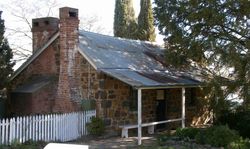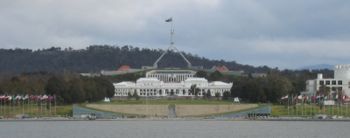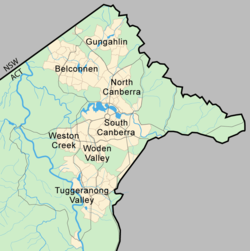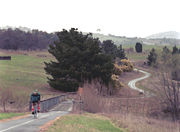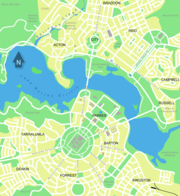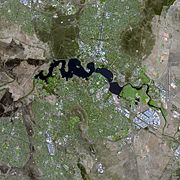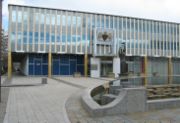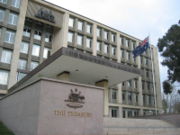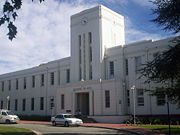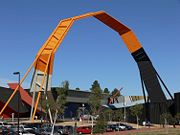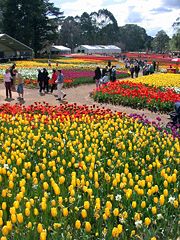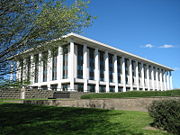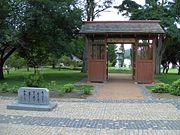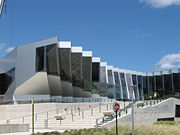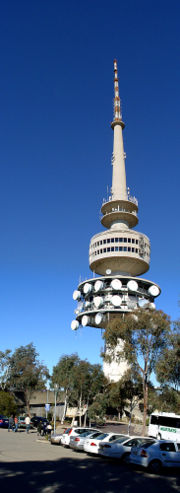Canberra
2008/9 Schools Wikipedia Selection. Related subjects: Cities; Oceania (Australasia)
| Canberra Australian Capital Territory |
|||||||
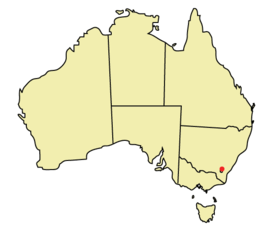 Location of Canberra within Australia |
|||||||
| Population: | 333,940 (June 2006) ( 8th) | ||||||
| • Density: | 1005/km² (2602.9/sq mi) (2006, including Queanbeyan) | ||||||
| Established: | 12 March 1913 | ||||||
| Coordinates: | Coordinates: | ||||||
| Area: | 805.6 km² (311.0 sq mi) | ||||||
| Time zone: • Summer ( DST) |
AEST ( UTC+10) AEDT ( UTC+11) |
||||||
| Location: | |||||||
| State District: |
|
||||||
| Federal Division: |
|
||||||
|
|||||||
Canberra (pronounced /ˈkænbɹə/) is the capital city of the Commonwealth of Australia. With a population of over 334,000, it is Australia's largest inland city. The city is located at the northern end of the Australian Capital Territory, 280 km (170 mi) south-west of Sydney, and 650 km (400 mi) north-east of Melbourne. The site of Canberra was selected for the location of the nation's capital in 1908 as a compromise between age-old rivals Sydney and Melbourne, Australia's two largest cities. It is unusual among Australian cities, being an entirely purpose-built, planned city. Following an international contest for the city's design, a design by the Chicago architects Walter Burley Griffin and Marion Mahony Griffin was selected and construction commenced in 1913. The city's design was heavily influenced by the garden city movement and incorporates significant areas of natural vegetation that have earned Canberra the title "bush capital". Although the growth and development of Canberra were hindered by the World Wars and the Great Depression, it emerged as a thriving city after World War II.
As the seat of the government of Australia, Canberra is the site of Parliament House, the High Court of Australia and numerous government departments and agencies. It is also the location of many social and cultural institutions of national significance, such as the National Gallery of Australia and the National Museum of Australia. The federal government contributes the largest percentage of Gross State Product and is the largest single employer in Canberra.
History
Before European settlement, the area in which Canberra would eventually be constructed was seasonally inhabited by the Ngunnawal and Walgalu tribes. The Ngarigo lived south-east of the Canberra area, the Gundungurra to the north, the Yuin on the coast and the Wiradjuri to the west. Archaeological evidence from the Canberra region suggests human habitation in the area for at least 21,000 years. The word "Canberra" is derived from the name of the local Ngabri people dialect, one of the Ngunnawal family groups, from the word Kanbarra meaning "meeting place" in the old Ngunnawal language. The Ngunnawal name was apparently used as a reference to corroborees held during the seasonal migration of the Ngunawal people to feast on the Bogong moths that pass through the region each spring.
European exploration and settlement started in the Canberra area as early as the 1820s. There were four expeditions between 1820 and 1824. White settlement of the area probably dates from 1824, when a homestead or station was built on what is now the Acton peninsula by stockmen employed by Joshua John Moore. He formally purchased the site in 1826, and named the property Canberry. The European population in the Canberra area continued to grow slowly throughout the 19th century. Among them was the Campbell family of "Duntroon"; their imposing stone house is now the officers' mess of the Royal Military College, Duntroon. The Campbells sponsored settlement by other farmer families to work their land, such as the Southwells of " Weetangera". Other notable early settlers included the inter-related Murray and Gibbes families, who owned the Yarralumla estate - now the site of the official residence of the Governor-General of Australia - from the 1830s through to 1881. The oldest surviving public building in the inner-city is the Anglican Church of St John the Baptist, in the suburb of Reid, which was consecrated in 1845. St John's churchyard contains the graves of many of the district's pioneers. As the European presence increased, the indigenous population dwindled, mainly from disease such as smallpox and measles.
The district's change from a New South Wales (NSW) rural area to the national capital started during debates over Federation in the late 19th century. Following a long dispute over whether Sydney or Melbourne should be the national capital, a compromise was reached: the new capital would be built in New South Wales, so long as it was no closer than 100 miles (160 km) to Sydney, with Melbourne to be the temporary capital while the new capital was built. Canberra was chosen as the site in 1908, as a result of survey work done by the government surveyor Charles Scrivener. The NSW government ceded the Federal Capital Territory (as it was then known) to the federal government. In an international design competition conducted by the Department of Home Affairs, on 1 January 1910, the design by Walter Burley Griffin and Marion Mahony Griffin was chosen for the city, and in 1913 Griffin was appointed Federal Capital Director of Design and Construction and construction began. On 12 March 1913, the city was officially given its name by Lady Denman, the wife of the then Governor-General Lord Denman at a ceremony at Kurrajong Hill, which has since become Capital Hill and the site of the present Parliament House. Canberra Day is a public holiday observed in the city and the surrounding Australian Capital Territory (ACT) on the second Monday in March to celebrate the founding of Canberra.
The federal government moved to Canberra on 9 May 1927, with the opening of the Provisional Parliament House. The Prime Minister, Stanley Bruce, had officially taken up residence in The Lodge a few days earlier. Planned development of the city slowed significantly during the depression of the 1930s and during World War II. Some projects planned for that time, for example, Roman Catholic and Anglican cathedrals, were never completed. The development of Canberra gained pace after the Second World War, and it has grown beyond the original planners’ expectations since then. Several Government departments, together with public servants, were moved to Canberra from Melbourne following the war. Government housing projects were undertaken to accommodate the city's growing population. Parts of Canberra's north and south were further developed in the 1950s, and urban development in the districts of Woden Valley and Belconnen commenced in the mid and late 1960s, respectively. Lake Burley Griffin was completed in 1963.
On 27 January 1972 the Aboriginal Tent Embassy was first established on the grounds of Parliament House; it was created to draw attention to indigenous rights and land issues and has been continuously occupied since 1992. On 9 May 1988, a larger and permanent Parliament House was opened on Capital Hill as part of Australia's bicentenary celebrations, and the Federal Parliament moved there from the Provisional Parliament House, now known as Old Parliament House. In December 1988, the ACT was granted full self-government through an Act of the Commonwealth Parliament. Following the first elections in February 1989, a 17-member Legislative Assembly sat at its offices in London Circuit, Civic, on 11 May 1989. The Australian Labor Party formed the ACT's first government, led by the Chief Minister Rosemary Follett, who made history as Australia's first female head of government.
On 18 January 2003, parts of Canberra were engulfed by a bushfire that killed four people and destroyed 491 homes and the major research telescopes and workshop at the Australian National University's Mount Stromlo Observatory.
Geography
Canberra covers an area of 805.6 square kilometres (311.0 sq. mi) and is located near the Brindabella Ranges (Brendy Bear Ranges), approximately 150 kilometres (93 mi) inland from Australia's east coast. It is located at altitudes that range from 550 metres to 700 metres (1,800 to 2,300 ft) AHD. The highest point is Mount Majura at 888 metres (2,913 ft). Other large hills include Mt Taylor, Mt Ainslie, Mt Mugga Mugga and Black Mountain. The surrounding bushland and the original bushland that Canberra was built in is a mixture of eucalyptus savanna, open grassland, scrubland, swamp and dry eucalyptus forests.
The Molonglo River flows through Canberra and has been dammed to form the body of water in the centre of the city called Lake Burley Griffin. The Molonglo then flows into the Murrumbidgee north-west of Canberra, which in turn flows north-west toward the New South Wales town of Yass. The Queanbeyan River joins the Molonglo River at Oaks Estate just within the ACT. A number of creeks, including Jerrabomberra and Yarralumla Creeks, flow into the Molonglo and Murrumbidgee. Two of these creeks, the Ginninderra and Tuggeranong, have similarly been dammed to form Lakes Ginninderra and Tuggeranong. Until recently the Molonglo had a history of sometimes lethal floods; the area was a flood plain prior to the filling of Lake Burley Griffin.
Climate
| Climate chart for Canberra | |||||||||||
|---|---|---|---|---|---|---|---|---|---|---|---|
| J | F | M | A | M | J | J | A | S | O | N | D |
|
59
28
13
|
56
27
13
|
51
25
11
|
46
20
6
|
45
16
3
|
41
12
1
|
41
11
0
|
47
13
1
|
52
16
3
|
63
19
6
|
64
23
9
|
53
26
11
|
| temperatures in °C precipitation totals in mm source: |
|||||||||||
|
Imperial conversion
|
|||||||||||
Canberra has four distinct seasons, because of its latitude, elevation and distance from the coast. The climates of most Australian coastal areas, which include all the state capital cities, are moderated by the sea. Canberra experiences hot, dry summers, and cold winters with heavy fog and frequent frosts, with a rare spot of snow in the CBD but the surrounding areas get annual snowfall through winter and often the snow capped mountains can be seen from the cbd. The highest recorded maximum temperature was 42.2 °C (108 °F) on 1 February 1968. The lowest recorded minimum temperature was −10.0 °C (14 °F) on 11 July 1971. Light snow falls in the city in one out of approximately three winters but is usually not widespread and quickly dissipates. Thunderstorms can occur between September and March, with rainfall maximums in spring and summer.
Urban structure
Canberra is a planned city that was originally designed by Walter Burley Griffin, a major 20th century American architect. Major roads follow a wheel-and-spoke pattern rather than a grid. The city centre is laid out on two perpendicular axes: a water axis stretching along Lake Burley Griffin, and a ceremonial land axis stretching from Parliament House on Capital Hill north-eastward along ANZAC Parade to the Australian War Memorial at the foot of Mt Ainslie. The area known as the Parliamentary Triangle is formed by three of Burley Griffin's axes, stretching from Capital Hill along Commonwealth Avenue to the Civic Centre around City Hill, along Constitution Avenue to the Defence precinct on Russell Hill, and along Kings Avenue back to Capital Hill.
The larger scheme of Canberra's layout is based on the three peaks surrounding the city, Mt. Ainslie, Black Mountain, and Bimberi Peak. ANZAC Parade, for instance is on the line between Ainslie and Bimberi. The Griffins assigned spiritual values to Ainslie, Black Mountain, and Red Hill and originally planned to cover each of these in flowers. That way each hill would be covered with a single, primary colour which represented its spriritual value. This part of their plan never came to fruition. In fact, WWI interrupted the contstruction and some conflicts after the war made it a difficult process for the Griffins. Nevertheless, Canberra stands as an exemplary city design and is located halfway between the ski slopes and the beach. It enjoys a natural cooling from geophysical factors.
Due to the fact that there is almost no orthogonal design in the city, Canberrans are wont to point in a direction when asked where something is located. Instructions to follow certain streets are exceptionally rare.
The urban areas of Canberra are organised into a hierarchy of districts, town centres, group centres, local suburbs as well as other industrial areas and villages. There are seven districts, each of which is divided into smaller suburbs, and most of which have a town centre which is the focus of commercial and social activities. The districts were settled in the following chronological order:
- North Canberra, mostly settled in the 1920s and '30s, with expansion up to the 1960s, now 15 suburbs
- South Canberra, settled from the 1920s to '60s, 12 suburbs
- Woden Valley, first settled in 1963, 13 suburbs
- Belconnen, first settled in 1967, 25 suburbs
- Weston Creek, settled in 1969, 8 suburbs
- Tuggeranong, settled in 1974, 19 suburbs
- Gungahlin, settled in the early 1990s, 7 suburbs to date
The North and South Canberra districts are substantially based on Walter Burley Griffin's designs. In 1967 the then National Capital Development Commission adopted the "Y Plan" which laid out future urban development in Canberra around a series of central shopping and commercial area known as the 'town centres' linked by freeways, the layout of which roughly resembled the shape of the letter Y, with Tuggeranong at the base of the Y and Belconnen and Gungahlin located at the ends of the arms of the Y. Development in Canberra has been closely regulated by government, both through the town planning process, but also through the use of crown lease terms that have tightly limited the use of parcels of land. All land in the ACT is held on 99 year leases from the national government, although most leases are now administered by the Territory government.
Most suburbs have their own local shops, and are located close to a larger shopping centre serving a group of suburbs. Community facilities and schools are often also located near local shops or group shopping centres. Many of Canberra's suburbs are named after former Prime Ministers, famous Australians, early settlers, or use Aboriginal words for their title. Street names typically follow a particular theme; for example, the streets of Duffy are named after Australian dams and weirs, and the streets of Page are named after biologists and naturalists. Most diplomatic missions are located in the suburbs of Yarralumla, Deakin and O'Malley. There are three light industrial areas: the suburbs of Fyshwick, Mitchell and Hume.
Governance
Outside Canberra, the Australian Capital Territory has no settlements larger than a village. The Australian Capital Territory Legislative Assembly performs the roles of both a city council and territory government. The Assembly consists of 17 members, elected from three districts using proportional representation. The three districts are Molonglo, Ginninderra and Brindabella, which elect seven, five and five members, respectively. The Chief Minister is elected by the Members of the Legislative Assembly (MLA) and selects another four MLAs to serve as Ministers to form, with the Chief Minister, an Executive (known informally as the cabinet.) At the 2004 election the Australian Labor Party, headed by Chief Minister Jon Stanhope, won nine of the 17 seats and formed the ACT's first majority government.
The Australian national government retains some influence over the ACT government. In the administrative sphere, most frequently this is through the actions of the National Capital Authority which is responsible for planning and development in areas of Canberra which are considered to be of national importance or which are central to Griffin's plan for the city, such as the Parliamentary Triangle, major approach and processional roads, areas where the Commonwealth retains ownership of the land or undeveloped hills and ridge-lines (which form part of the Canberra Nature Park). The national government also retains a level of control over the Territory Assembly through the provisions of the Australian Capital Territory (Self-Government) Act 1988. This Act of the national Parliament is the constitution for the ACT and limits the range of matters upon which the Assembly can legislate.
The Australian Federal Police provides all of the police services of a state police force under a contractual agreement with the Australian Capital Territory Government. People who have been charged with offences are tried either in the ACT Magistrate's Court or, for more severe offences, the ACT Supreme Court. Prisoners can be held in remand at the Belconnen Remand Centre in the ACT. As at 2008 there is no prison in the ACT, so people who have been sentenced to imprisonment serve their sentence in NSW; a new prison, the Alexander Maconochie Centre, is currently under construction. Courts such as a Small Claims Tribunal and a Family Court exist for civil law actions and other non-criminal legal matters.
Economy
As of July 2006, the unemployment rate in Canberra is 2.8%, well below the national unemployment rate of 4.8%, with labour shortages reported in some sectors. As a result of low unemployment and substantial levels of public sector and commercial employment, Canberra has the highest average disposable income of any Australian capital city. The gross average weekly wage of a Canberra resident is $1,208.50, compared with the Australia wide average of $1,043.10. The median house price in Canberra as of June 2005 was $352,500, lower than Sydney, Melbourne and Perth but higher than all other capital cities. The median house price in September 2006 was $375,000 The average price in November 2006 was $411,305. The median weekly rent paid by Canberra residents is higher than rents in all other states and territories. As at the September quarter of 2006 the median rent for a 3 bedroom house was $320 per week. This is the highest of all capital cities in Australia. The median rent for 'other' dwellings is $300 per week.
The city's main industry is government administration and defence, which accounted for 26.1% of Gross Territory Product in 2003–04 and employed over 40% of Canberra's workforce. The major public-sector employers in Canberra include the parliament and government departments such as Department of Defence, Finance, Foreign Affairs and Trade, and Treasury. A number of Australian Defence Force establishments are located in or near Canberra, most notably the Australian Defence Force headquarters and HMAS Harman, which is a naval communications centre that is being converted into a tri-service, multi-user depot. The former RAAF Fairbairn, adjacent to the Canberra International Airport was sold to the operators of the Airport, but the base continues to be used for RAAF VIP flights.
A growing number of independent software vendors have based themselves in Canberra, to capitalise on the concentration of government customers. Notable among these are QSP, Tower Software, RuleBurst and The Distillery. Property and business services, construction, health and community services, and education are other significant contributors to the economy of Canberra.
Demographics
As of 2006, the population of Canberra was 325,800 people, and the city has a population density of 401.0 persons per square kilometre (1,038.6/sq mi), which is dense with respect to other Australian cities. The 2001 census showed that 1.2% of Canberra's population were of indigenous origin and 21.6% were born overseas. The largest group of people born overseas came from English-speaking countries, led by the United Kingdom and then New Zealand. Significant numbers of immigrants have also come from Germany, Italy and Vietnam. Recent immigrants have arrived from countries in east and south Asia. Most Canberrans are native speakers of English; many have a second language, the most common being Chinese, Italian, Croatian and Greek.
Canberrans are relatively young, highly mobile, and well educated. The average age is 32 years, and only 8.3% of the population is aged over 65 years. Between 1996 and 2001, 61.9% of the population either moved to or from Canberra, which is the second highest mobility rate of any Australian capital city. As of May 2004, 30% of people in the ACT aged 15–64 had a level of educational attainment equal to at least a bachelor's degree, significantly higher that the national average of 19%. Approximately 50% of Canberra residents describe themselves as Christian, the most common denominations being Catholic and Anglican; less than 3% of the population practice a non-Christian religion and 23% are not religious.
As of 2002 the most common crimes in Canberra are property related crimes, unlawful entry with intent and motor vehicle theft. They affect 1,961 and 630 of every 100,000 persons respectively. Homicide and related offences (including Murder, Attempted Murder, Manslaughter and Driving Causing Death) affect 1.5/100,000 persons which is below the national average of 4.9/100,000. Rates of assault and sexual assault are also below the national average.
Education
The two main tertiary institutions are the Australian National University (ANU) in Acton and the University of Canberra (UC) in Bruce. The ANU was established as a research university in 1946; it continues to have a strong research focus and is ranked among the best universities in the world in The Times Higher Education Supplement and the Shanghai Jiao Tong World University Rankings. Both ANU and UC also have campuses interstate and overseas. There are also two religious university campuses in Canberra: Signadou in the North Canberra suburb of Watson is a campus of the Australian Catholic University; St Mark's Theological College adjacent to the Parliament House is a campus of the secular Charles Sturt University.
The Australian Defence Force Academy (ADFA) and the Royal Military College, Duntroon are near the suburb of Campbell in Canberra's inner north-east. ADFA teaches military undergraduates and postgraduates and is officially a campus of the University of New South Wales; Duntroon provides Australian Army Officer training. Tertiary level vocational education is also available through the multi-campus Canberra Institute of Technology.
In February 2004 there were 140 public and non-governmental schools in Canberra; 96 were operated by the Government and 44 are non-Government. During 2006 the ACT Government announced closures of up to 39 schools, to take effect from the end of the school year and after a series of consultations the Government announced its "Towards 2020: Renewing Our Schools" plan that closed some schools at the end of 2006 with more in 2007 and 2008, while consolidating school campuses and opening 'super-schools' (large public schools for kindergarten through to year 12) through to 2020. Most suburbs are planned to include a primary school and a nearby preschool, and schools are usually located near open areas for play and sports.
Culture
Arts and entertainment
Canberra is home to many national monuments and institutions such as the Australian War Memorial, the National Gallery of Australia, the National Portrait Gallery currently housed at Old Parliament House, the National Library of Australia, the National Archives of Australia, and the National Museum of Australia. Many Commonwealth government buildings in Canberra are open to the public, including Parliament House, the High Court and the Royal Australian Mint. Lake Burley Griffin is the site of the Captain Cook Memorial and the National Carillon. Other sites of interest include the Telstra Tower and the Australian National Botanic Gardens on Black Mountain, the National Zoo and Aquarium on Scrivener Dam, the National Dinosaur Museum and Questacon – the National Science and Technology Centre.
The Canberra Museum and Gallery in Civic is a repository of local history and art. Several historic homes are open to the public: Lanyon and Tuggeranong Homesteads in the Tuggeranong Valley, Mugga-Mugga in Symonston, and Blundells' Cottage in Parkes all display the lifestyle of the early European settlers. Calthorpes' House in Red Hill is a well preserved example of a 1920s house from Canberra's very early days. Duntroon House, in the suburb of Campbell, was one of the district's earliest homesteads and is now the officers' mess at Royal Military College; it is occasionally open to the public.
Canberra has many venues for live music and theatre: the Canberra Theatre and Playhouse which hosts many major concerts and productions; and Llewellyn Hall (within the ANU School of Music), a world-class concert hall are two of the largest. The Street Theatre, also located on Childers Street, operates as a venue for local professional and amateur production companies, as well as producing a season of professional shows each year. The Albert Hall was the city's first performing arts venue, opened in 1928. It was the original performance venue for theatre groups such as the Canberra Repertory Society and the Canberra Philharmonic Society. The city boasts a very large number of amateur theatre groups for its population base, including many that focus primarily on musicals.
Stonefest at the University of Canberra is Canberra's largest music festival. Canberra is also the home turf of an Australian hip-hop duo, Koolism. There are numerous bars and nightclubs which also offer live entertainment, particularly concentrated in the areas of Dickson, Kingston and the City Centre. Most town centres have facilities for a community theatre and a cinema, and they all have a library. Popular cultural events include the National Folk Festival, the Royal Canberra Show, the Summernats car festival, the Canberra Multicultural Festival in February and the Celebrate Canberra festival which is held over 10 days in March in conjunction with Canberra Day.
Canberra has a number of sister cities, including Atlanta in the United States, Beijing in China, Dili in East Timor, Nara in Japan, and Versailles in France. Cultural exchange happens to some extent with each city. The largest community event associated with a sister city is the Canberra Nara Candle Festival which is held in October.
Sport
In addition to local sporting leagues, Canberra has a number of sporting teams that compete in national and international leagues. The best known teams are the Canberra Raiders and the ACT Brumbies who play rugby league and rugby union respectively, and who have both been champions of their leagues. Both teams play their home games at Canberra Stadium, which is Canberra's largest stadium and was used to hold preliminary soccer matches for the 2000 Summer Olympics and matches for the 2003 Rugby World Cup. Canberra also has a successful basketball team, the Canberra Capitals. The Canberra Capitals won the 2006 and 2007 women's basketball Grand Final.
There are also teams that participate in national competitions in netball, field hockey, ice hockey and cricket. Manuka Oval is another large outdoor sporting facility where cricket and Australian Rules football are played. The Melbourne based AFL team the Kangaroos played some home games at Manuka Oval until July 2006. Following the move of the Kangaroos' alternative home ground to Carrara in Queensland, Melbourne and the Western Bulldogs will play home games at Manuka Oval from 2007 against the Sydney Swans. Canberra is also home to the Barassi International Australian Football Youth Tournament. The historic Prime Minister's XI cricket match is played at Manuka Oval annually. Other significant annual sporting events include the Canberra Marathon and the City of Canberra Half Ironman Triathlon. The Canberra Women's Tennis Classic was held in the lead up to the Australian Open until 2006.
The Australian Institute of Sport (AIS) is located in the Canberra suburb of Bruce. The AIS is a specialised educational and training institution providing coaching for elite junior and senior athletes in a number of sports. The AIS has been operating since 1981 and has achieved significant success in producing elite athletes, both local and international. The majority of Australia's team members and medals at the 2000 Summer Olympics in Sydney were won by AIS graduates. It is also a popular tourist destination.
Canberra has numerous sporting ovals, golf courses, skate parks, tennis courts and swimming pools that are open to the public. A Canberra-wide series of bicycle paths are available to cyclists for recreational and sporting purposes. Canberra Nature Parks have a large range of walking paths, horse and mountain bike trails. Water sports like sailing, rowing and water skiing are popular activities on Canberra's lakes. The Rally of Canberra is an annual motor sport event and a facility for drag racing is currently being planned for construction.
Infrastructure
Health
Canberra has two large public hospitals, the 500-bed Canberra Hospital - formerly the Woden Valley Hospital - located in Garran and the smaller 174 bed Calvary Public Hospital located in Bruce. Both public hospitals are also teaching hospitals. The largest private hospital in Canberra is the John James Memorial Hospital in Deakin. Calvary Private Hospital in Bruce and Healthscope's National Capital Private in Garran are also major healthcare providers. The Royal Canberra Hospital was located on Acton Peninsula on Lake Burley Griffin; it was closed on 27 November 1991 and was demolished in 1997 in a controversial implosion. This was to facilitate construction of the National Museum of Australia. The city has 10 aged care facilities. Canberra's hospitals receive emergency cases from throughout southern New South Wales. The ACT Ambulance Service is one of four operational agencies of the ACT Emergency Services Authority.
Transport
The car is by far the dominant form of transport in Canberra. Past planning policies have resulted in well developed good quality roads and a low population density spread over a relatively large area of the city. Canberra's districts are generally connected by 'parkways' - limited access dual carriageway roads with speed limits generally set at 80 to 100 km/h. An example is the Tuggeranong Parkway which links Canberra's CBD and Tuggeranong, and bypasses Weston Creek. In most districts, discrete residential suburbs are bounded by access roads.
A publicly run bus service, the Australian Capital Territory Internal Omnibus Network (ACTION), provides public transport throughout the city. Transborder Express and Deane's Buslines are private coach services that operate within Canberra and nearby areas of New South Wales. Only 4.6% of the population use the bus system. Another 5.5% walk or cycle to work, a higher proportion than in any other Australian capital city. A private bus service operates between Canberra and Queanbeyan, an adjoining town in New South Wales. There are two local taxi companies, Aerial Consolidated Transport the parent of the Canberra Cabs service which enjoyed monopoly status for over four decades, and a recent arrival, Cabxpress.
An interstate CountryLink railway service connects Canberra to Sydney. Canberra's railway station is in the inner south suburb of Kingston. Between 1920 and 1922 the train line crossed the Molonglo River and ran as far north as the city centre, although the line was closed following major flooding and was never rebuilt. Train services to Melbourne are provided by way of a CountryLink bus service which connects with a rail service between Sydney and Melbourne in Yass, about one hour's drive from Canberra. Plans to establish a very fast train like a TGV service between Melbourne, Canberra and Sydney have been contemplated, but not implemented by both government and private enterprise, as various proposals have not been deemed economically viable. The plan was shelved by former Federal Transport Minister John Anderson in 2000.
Canberra is about three hours by road from Sydney on the Federal Highway (National Highway 23), which connects with the Hume Highway (National Highway 31) near Goulburn, and seven hours by road from Melbourne on the Barton Highway (National Highway 25), which joins the Hume Highway at Yass. It is a two hour drive on the Monaro Highway (National Highway 23) to the ski fields of the Snowy Mountains and the Kosciuszko National Park. Batemans Bay, a popular holiday spot on the New South Wales coast, is also two hours away via the Kings Highway.
Canberra International Airport provides direct domestic services to Sydney, Melbourne, Brisbane, Adelaide and Perth, with connections to other domestic centres. There are direct daily flights to Albury and Newcastle in New South Wales. No regular commercial international flights operate from the airport. Until 2003 the civilian airport shared runways with RAAF Base Fairbairn. On 27 June of that year, the Air Force base was decommissioned and from that time the airport was fully under civilian control.
Utilities
The ACT government owned ACTEW Corporation manages Canberra's water and sewerage infrastructure. ActewAGL is a joint venture between ACTEW and AGL, and is the retail provider of Canberra's utility services including water, natural gas, electricity, and also some telecommunications services via a subsidiary TransACT. Since 2003 all ACT consumers have been able to choose the electricity retailer of their choice. Canberra's water is stored in four reservoirs, the Corin, Bendora and Cotter dams on the Cotter River and the Googong Dam on the Queanbeyan River. The Googong Dam is in New South Wales but it is managed by the ACT government. ACTEW Corporation owns Canberra's two wastewater treatment plants, located at Fyshwick and at Lower Molonglo on the Molonglo River.
Electricity for Canberra comes from the national power grid through substations at Holt and Fyshwick (via Queanbeyan). Some limited local renewable power is produced via a hydro generator on the main water supply pipeline for Canberra at Mount Stromlo and methane plants at waste landfill sites at Belconnen and Mugga Lane. The first domestic power supply in Canberra was in 1913 for the suburb of Acton. Unlike most Australian cities, the power poles in Canberra's older suburbs are located along the rear boundaries of residential housing lots rather than on the street front. In newer areas the power supply and communications cabling are located underground.
As in other parts of Australia, terrestrial and mobile telecommunications services are provided by a range of competing companies. The majority of the infrastructure is owned by Telstra but some is owned by TransACT (a Canberra-based communications company) as well as other providers. The ACT has the highest rate of computer use and internet connection in Australia.
